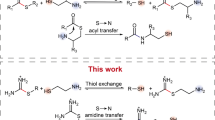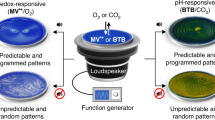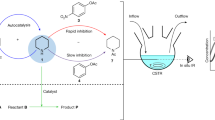Abstract
Interest in oscillating chemical reactions arises because these systems serve as models of temporal organization in biological systems, as starting points for the development of spatial structure in initially homogeneous systems and as instructive examples of the wide variety of dynamic phenomena possible in chemical systems far from equilibrium. One obstacle to the development of a general theory of chemical oscillation has been the small number of fundamentally distinct homogeneous oscillators and the failure of efforts to design new oscillating reactions. We recently suggested a systematic approach to the construction of chemical oscillators and used it to produce a homogeneous oscillating reaction: the chlorite–iodate–arsenite oscillator1. We now report that the above system is the prototype of a family of homogeneous oscillators, all of whose members have the species chlorite and iodate in common, but which can utilize a wide variety of reducing agents or substrates in place of arsenite.
This is a preview of subscription content, access via your institution
Access options
Subscribe to this journal
Receive 51 print issues and online access
$199.00 per year
only $3.90 per issue
Buy this article
- Purchase on Springer Link
- Instant access to full article PDF
Prices may be subject to local taxes which are calculated during checkout
Similar content being viewed by others
References
De Kepper, P., Epstein, I. R. & Kustin, K. J. Am. chem. Soc. 103, 2133–2134 (1981).
Bognár, J. & Sárosi, S. Analyt. chim. Acta 29, 406–411 (1963).
Eggert, J. & Scharnow, B. Z. Electrochem. 27, 455–470 (1927).
Kern, D. M. & Kim, C.-H. J. Am. chem. Soc. 87, 5309–5313 (1965).
de Meeus, J. & Sigalla, J. J. chim. Phys. 63, 453–459 (1966).
Dateo, C., Orbán, M., DeKepper, P. & Epstein, I. R. J. Am. chem. Soc. (in the press).
Boissonade, J. & De Kepper, P. J. phys. Chem. 84, 501–506 (1980).
Latimer, W. M. Oxidation Potentials 2nd edn (Prentice Hall, Englewood Cliffs, 1964).
Clark, W.M. Oxidation–Reduction Potential of Organic Systems, 470 (Williams and Wilkins, Baltimore, 1960).
Author information
Authors and Affiliations
Rights and permissions
About this article
Cite this article
Orbán, M., De Kepper, P., Epstein, I. et al. New family of homogeneous chemical oscillators: chlorite–iodate–substrate. Nature 292, 816–818 (1981). https://doi.org/10.1038/292816a0
Received:
Accepted:
Issue Date:
DOI: https://doi.org/10.1038/292816a0
This article is cited by
-
From classical metal-catalyzed homogeneous oscillators to an uncatalyzed version of the Belousov–Zhabotinsky reaction: a review
Reaction Kinetics, Mechanisms and Catalysis (2022)
-
Autocatalytic and oscillatory reaction networks that form guanidines and products of their cyclization
Nature Communications (2021)
-
Belousov-Zhabotinsky type reactions: the non-linear behavior of chemical systems
Journal of Mathematical Chemistry (2021)
-
Crystals from dreams
Nature (1991)
-
Bistable and oscillating chemical reactions
Journal of Statistical Physics (1987)
Comments
By submitting a comment you agree to abide by our Terms and Community Guidelines. If you find something abusive or that does not comply with our terms or guidelines please flag it as inappropriate.



